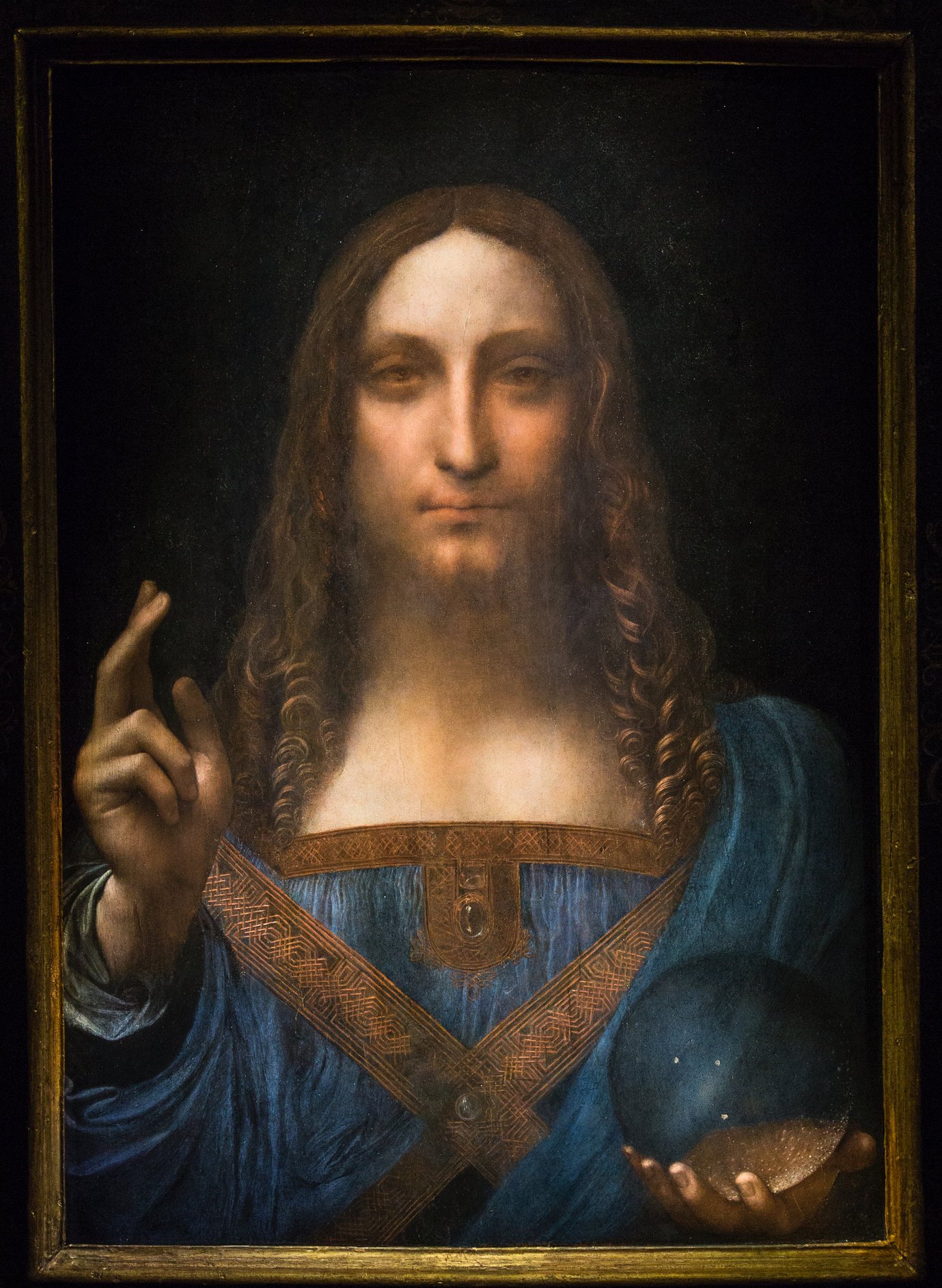By Jiei Yamasato, Year 12
First Encounter
The rich brown hair. The silky blue cloak. The pure glass orb. The confidently raised hand. Although masterfully executed, none of these elements grab the viewers’ eyes nearly as much as the eyes. At either side of the stern nose, lie foggy ominous eyes that escape the canvas and seep into the minds of those watching, to the point where it might even get uncomfortable, for introverts like me.
However, as you let the figure sink into your consciousness, a faint sense of comfort arises. It’s just you and the figure in this closed environment, but it’s not at all cold or scary, in fact, the space is warm and encouraging. It is almost as if the figure has come to find you in the darkness, just to guide you back to light, reassuring you on the way that everything will be alright. Where is this sensation coming from?
Salvator Mundis
“Salvator Mundi” is Latin which roughly translates to “savior of the world”. A popular theme, this savior of the world has been painted by countless artists. But interestingly, no artist has been able to spark the hopefulness and intrigue Leonardo has in his version. How is this so? Let’s compare Leonardo’s painting with another, done by the Master of the Darmstadt Passion around 1460.
Salvator Mundi (1460) – Master of the Darmstadt Passion
Immediately, most people should notice a feeling of concern. The supposed savior of the world is looking off somewhere in the distance God knows where, the big golden disc behind the head, the huge orb (known officially as the ‘globus cruciger’), and the heavily jeweled double-sided cloak all make the figure quite intimidating. The frail hand is raised with no care, while the pink lips apathetically dip down on either side. This all stands in front of a flat blue wall. This version of Salvator Mundi is far too alienating to viewers. It portrays the central figure not as a powerful yet selfless being like Leonardo’s version, but as a divine being who couldn’t give much care to simpletons.
In Leonardo’s version, the hand looks healthy, the orb is kept as inconspicuous as possible (invisible), whilst the clothing is not overly decorated although it still keeps some necessary details. The black background prevents anything from deviating the viewer’s attention from the figure, finally bringing us to the face. The face of the savior is a great example of one of Leonardo’s iconic techniques: sfumato. Italian for ‘nuanced’ or ‘vanishing’, sfumato is a technique whereby painting several layers on top of one another, the borders of lines are made more vague, natural, and smooth. Like in Leonardo’s most famous painting: the Mona Lisa, this creates a sort of hazy feel to the painting as a whole, but specifically for detailed parts such as the face, sfumato creates a sort of ambiguity to the exact form depicted. This ambiguity is the main key to solving the mystery.
Mona Lisa (1519)- Leonardo da Vinci
The savior’s eyes do not have clearly defined pupils. While it is possible to vaguely make out that the figure is facing straight forward, there is no evident judgment to be felt from the eyes. Are they proud? Are they disappointed? Are they worried? The eyes do not tell the whole story. To seek more information, instinctively humans look at the mouth. Perhaps the mouth will be smiling or frowning and that will inform us of what the figure thinks. Alas, this time the sfumato on the lips clouds up our exact perception of the expression. The exact point at which the lips converge is made unclear, producing a very peculiar effect, where it is made up to each individual viewer to decide what they think the figure is feeling.
It is within this ambiguity, which I believe the true power of this painting lies. As the painting allows for individually variable interpretations, it speaks to anyone and everyone. Perhaps to someone who just got a 4 on their math test, they feel encouragement from the savior’s countenance. On the other hand, perhaps to someone who just got a 7 on the same test, the savior shows feelings of commendation, encouraging to keep up the good work. Either way, the painting brings comfort and courage. Now, who else always manages to bring students in our school comfort and courage…?
What this Means Today for Us
Believe it or not, this is not a matter only concerning the long-gone Renaissance days. A phenomenon very similar to Salvador Mundi can be seen in our Ecolint community. “Where?” you may ask. Well, none other than in Dr.Hughes’ assembly videos.
220401_SS_NwsL.mp4 (2022) – Conrad Hughes
Once examined carefully, many similarities can be drawn between some of Dr. Hughes’ newsletter videos and Leonardo da Vinci’s painting. The blue suit, the confident hands, and most of all, the powerful eyes, piercing into each and every one of our hearts. While far more passionate and animated, Dr. Hughes helps all of us just as much as, or even to a further extent than the savior. With his brilliant charisma and helpful advice, Dr. Hughes leads pupils of our school to a brighter future for our academics, our personal lives, and the world.
Extra Information
Leonardo da Vinci (1452-1519) is one of if not the greatest artists of the Renaissance period, which took place from the 14th to 17th century, when many classic values were imported into the art field, leading artists to strive for more accurate depictions of reality, prompting research into perspective, composition, and human anatomy. Leonardo himself is famous for having sketches of various human body parts. It is said that Leonardo invented his sfumato technique as he frequently made retouches to his paintings which he carried around, searching for commissions.
Interestingly enough, Salvator Mundi had a very late rise to fame, as depicted in the 2021 documentary The Lost Leonardo. Initially sold for around $200, the painting is now worth more than $450,000,000. Makes you wonder what determines the value of art.
Art History Club is held every Tuesday from 12:40 to 13:20 in the IB room. For more information and updates, check out the Instagram account @lgb.arthistoryclub or contact [jiei.yamasato@learning.ecolint.ch].



